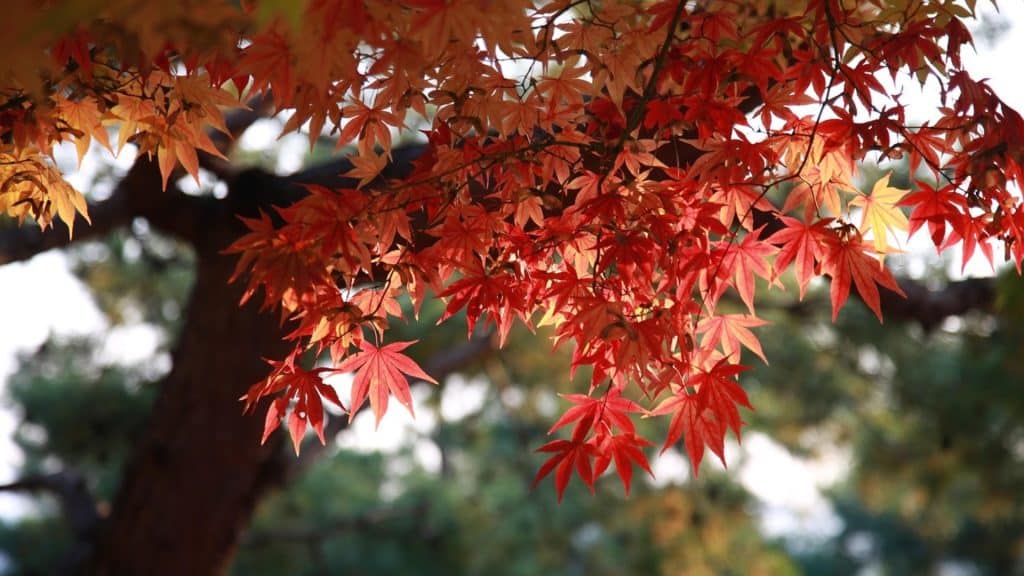What makes maple trees so special? Is it their colorful leaves, strong trunks, or sweet syrup? The answer is all of these!
Maple trees have been part of our world for centuries. They add beauty, give shade, help wildlife, and provide useful materials like wood and syrup.
With over 120 species, they’re one of the most useful and well-known trees.
There’s a lot more to maple trees than you might think, and these facts will help you see them in a whole new way.
Fun & Unique Facts About Maple Trees
Maple trees are more than just beautiful; they’re full of surprises.
From their impressive size to their unique features, here are facts that highlight why maples are so special.
1. Longevity Like No Other
Maple trees can live for more than 300 years, making them symbols of enduring strength and resilience in nature. These ancient giants stand tall through decades of changing landscapes.
2. A Leafy Signature
The leaves of maple trees always have an odd number of lobes.
This unique characteristic sets them apart from many other tree species, making their leaves instantly recognizable, especially in the fall.
3. Helicopter Seeds
Maple seeds, known as samaras, have a special design that causes them to spin like little helicopters when they fall.
This helps them travel great distances from their parent tree, ensuring the next generation of maples grows far and wide.
4. More Than 120 Varieties
Maple trees come in over 120 different species, ranging from the towering sugar maple to the ornamental Japanese maple.
Each variety has its unique characteristics and uses, making them incredibly versatile.
5. A Symbol of Canada
The maple leaf holds great importance as a national symbol of Canada.
It is featured on the Canadian flag and represents the country’s connection to nature and resilience.
6. Gender-Shifting Trees
In some species of maple, the trees can change their gender throughout their lives.
This unique ability allows them to adapt to their environment, ensuring that the tree can reproduce as needed.
7. Maple’s Sweet Gift
A single sugar maple tree can produce up to 50 gallons of sap annually, which is harvested to make the beloved maple syrup.
This sap provides a natural sweetness that has become a favorite in kitchens worldwide.
8. Natural Climate Control
Maple trees play an important role in cooling the environment.
Their broad canopies provide shade, and their transpiration process helps maintain a more comfortable temperature, especially in urban areas.
9. Native Wisdom
Native Americans were the first to perfect the art of tapping maple trees for sap and turning it into syrup.
This tradition has been passed down through generations, long before European settlers adopted the practice.
10. Maple Trees Feed Wildlife
Maple trees are crucial to many animals, providing food in the form of their seeds, sap, and leaves.
Squirrels, deer, and birds all rely on maples for nutrition, especially in the colder months when other food sources are scarce.
11. Maple Wood is Highly Valued for Craftsmanship
Maple wood is prized by artisans and manufacturers for its strength, durability, and fine grain.
It is commonly used to make furniture, flooring, musical instruments like violins and guitars, and even bowling pins. Its hardness and smooth finish make it ideal for projects that require both beauty and resilience.
12. A Living Legacy
The maple tree’s presence in human culture stretches back centuries.
From the cultural significance of the maple leaf to its use in everything from furniture-making to musical instruments, the maple is a tree deeply woven into human history.
Types of Maple Trees
There are many species of maple trees, each with its unique features. Some are known for their syrup, while others are admired for their beauty and shade. Let’s look at a few popular types.
| Tree Type | Height | Fall Colors | Key Features | Soil Preferences | Primary Uses |
|---|---|---|---|---|---|
| Sugar Maple | Up to 100 ft | Orange & Red | Produces maple syrup sap | Moist, well-drained, cooler climates | Syrup production, shade |
| Red Maple | Medium–Large | Bright Red | Red flowers & leaves, fast adaptation | Wide range of soil types | Shade, parks, residential |
| Japanese Maple | Up to 25 ft | Red, Orange, Purple | Delicate, finely cut leaves | Partial shade, moist soil | Ornamental gardens, bonsai |
| Silver Maple | Up to 80 ft | Yellow–Green | Silvery leaf undersides | Wet, flood-prone areas | Quick shade, flood zones |
| Norway Maple | Up to 60 ft | Bright Yellow | Pollution tolerant, dense shade | Poor soil, urban conditions | Urban landscaping, streets |
Growing Your Own Maple Tree
Growing a maple tree is easy when you follow these simple steps.
- Choose the right spot: Pick a sunny or partly shaded area with good drainage and slightly acidic soil.
- Give space to grow: Make sure your tree has room to spread wide without crowding buildings or other trees.
- Dig properly: Make a hole twice as wide as the root ball and place the tree at ground level.
- Water deeply: Water slowly and thoroughly after planting to help roots settle into the soil.
- Mulch around the base: Use wood chips or bark to keep soil moist and protect roots from weather changes.
- Prune in winter: Remove dead or damaged branches during late winter to encourage healthy new growth.
- Check regularly: Watch for pests or diseases and water often during hot, dry weather.
With proper care and patience, your maple tree will grow strong and beautiful for years to come.
The Bottom Line
Maple trees do more than just look pretty in fall.
They help animals, give shade, and grow strong for many years in parks, forests, and backyards.
If you ever see one, take a moment to enjoy its leaves, shape, or even the sticky sap it hides inside.
Whether you plant one or just admire one from a distance, maple trees are a great reminder of how valuable and beautiful trees can be.
Share one of these facts with someone today. You never know who else might enjoy learning something cool about trees.





















